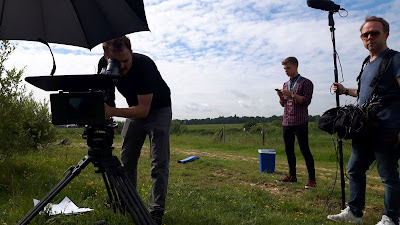On Wednesday, the BBC Natural History Unit were here filming a piece for The One Show about our colony of rare Long-horned Bees, and despite the variable weather, we managed to find them a stonking number of both male and female Eucera longicornis.
Long-horned Bee nesting site, North West Zone (just north of the runway)
Along this section of the River Mole are some decent patches of Meadow Vetchling, where the males can be found nectaring, and a large clay mound, which is one of our main solitary bee nesting sites. We could even see females jostling each other at burrow entrances.
Long-horned Bee (Eucera longicornis) male
Female burrow with fresh excavations
The wildlife camera guy Tom had his work cut out though, as these bees are bloomin' hyperactive when the sun is out, then can disappear again in the blink of an eye as clouds roll in!
Wildlife filmmaker Tom Hartwell

This tiny fella is ready for his close-up
My part (if not so terrible that they decide to edit me out), was to carefully handle a male Eucera, holding it by two of the legs in order to avoid damaging him. I said a few things to the presenter George McGavin about them, which I really hope now wasn't a load of woolly crap.
In any case, what a fantastic opportunity to air the plight of this species, and to show off the support they get here at Gatwick. Perhaps this sort of exposure can galvanize other landowners into looking after their pollinators, as many of these species are truly on the brink.
Entomologist and TV presenter George McGavin, the BBC natural history unit, Stephen from Gatwick Communications, and my coolbox of mysteries
In fact, I dug around online for literature on Eucera longicornis and was really taken aback to hear how rapidly this bee is declining, particularly after reading this worrying report form Cornwall by Kernow Ecology (...around 75% loss of colonies at the important Cornish sites?!! That's truly awful).
River Mole grassland wildflowers: Ragged Robin (Lychnis flos-cuculi), Grass Vetchling (Lathyrus nissolia), Meadow Vetchling (Lathyrus pratensis)
Our only other species of Long-horned Bee in the UK, (Eucera nigrescens), is effectively extinct, and there are no guarantees that our longicornis friends will stick around. We already know habitat loss is a huge problem, but there are almost certainly hidden dangers too, such as potential effects of pesticides and fungicides (as being researched by University of Sussex.)
Fortunately here at Gatwick, what we do have is the right habitat and the means to manage it well! The seeded wildflower mix along the River Mole contains an abundance of plants from the Fabaceae and Lamiaceae families, which are hugely important to Eucera, as well as raised banks of bare clay for nesting. .
I hear that the piece might air in 3 weeks or so, but the One Show schedule is very much subject to change. When I find out I'll do a 'heads up' on Twitter.
The plant species we have seen being used as forage by Long-horned Bees at Gatwick include:
Meadow Vetchling (Lathyrus pratensis)
Grass Vetchling (Lathyrus nissolia)
Common Vetch (Vicia sativa)
Red Clover (Trifolium pratense)
Bugle (Ajuga reptans)
Ground Ivy (Glechoma hederacea)
Common Comfrey (Symphytum officinale)
Gatwick receives conservation advice for this species from organisations such as Sussex and Surrey Wildlife Trusts, Buglife and BWARS (Bees, Wasps and Ants Recording Society).








No comments :
Post a Comment